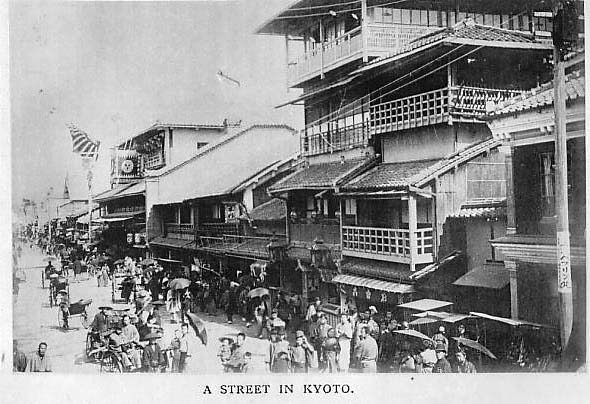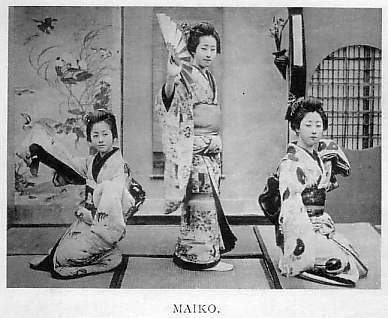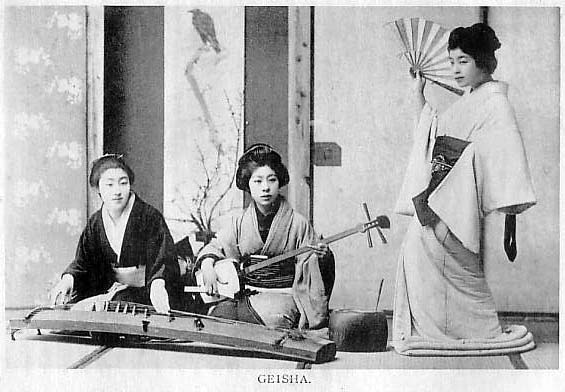The Miyako-Odori; a Japanese Ballet
Kioto, Feb.5th, 1887
The Times - May 7th.
Kioto, the western capital of Japan, is now en fete, and basking in the sunshine of Royalty.
After an interval of a decade, the Mikado has again favoured with his presence the ancient city, so rich in historical association and in the natural beauty of its surroundings, in which his ancestors, the spiritual rulers of Japan, were born and lived and died during an unbroken period of nearly 1,100 years.
And again the spacious palace, remarkable rather for exquisite and refined simplicity than for characteristics of a more striking kind, is filled with the stir and ceremonial of the Imperial Court.
But, compared with the austere routine which existed as lately as twenty years ago, the circumstances now attending the presence of the Mikado in the home of his forefathers and of his own youth present a truly extraordinary contrast.
In feudal times the palace was virtually the prison of the Mikado.
Immured within its gates and never seen by his subjects, he lived a life of rigid and mysterious seclusion.
Under the new order of things Japan's present Monarch goes freely over the city and neighbourhood, beholding and beheld by the people of all degrees.
He visits schools, exhibitions, and temples, inspect public works and institutions, and reviews his troops and squadrons.
He is, in short, even as other Sovereigns, a palpable and living reality, a ruler in deed as well as in name.
In one respect, however, His Majesty's position has most happily unchanged.
Neither time nor reform seems to have lessened in any appreciable degree those sentiments of loyalty and devotion with which the Japanese nation at large have ever regarded the revered person of the Sovereign.
In the hearts of the people he is still, as of old, verily the King of Kings.
It is no wonder then that the city of the Mikados has put on full holiday garb, to do honour to the occasion of a month's visit by the Imperial party, consisting of the Emperor and Empress, the Dowager-Empress and certain Princes of the Blood.
The clean streets of the goodly old capital seem cleaner than ever.
The national flag hangs from nearly every house.
Citizens, for the most part arrayed in their best, wear that air of simple easy-going recreation which comes so naturally to the pleasure-loving Japanese.
Bright dresses of girls and children fill the streets with life and colour.
The shop-fronts are at their gayest; decorations abound; and everywhere endless rows of many colored paper lanterns, of imposing size, embellish the long straight thoroughfares by day and produce the fairest of effects by night.
Lastly, a Fine Art Exhibition, for the display of old and new objects of art, has been opened in the castle grounds, and is in every respect worthy of a city and district long distinguished as the head-quarters of the cleverest of the renowned potters, embroiderers, weavers, and other artist-artisans of Japan.
It would have been strange if among the preparations for the Imperial visit, there had not been included some special form of entertainment by the celebrated Maiko, or danseuses of Kioto.
Stage-dancing in Japan is an institution of great antiquity.
It may almost be said to date from the occasion, far back in the hoary past, when, according to Japanese mythology, the Sun-Goddess, regarded as the ancestress of the Imperial family, was tricked into peeping out of her cave-retreat by the noisy revels of the gods and the sprightly dancing of her beautiful sister-divinity Ama-no-Usume.
That legendry dance, at all events, is regarded as the origin of Japanese theatrical representation.
At first the dancing ceremonies, thus devised, were only practised as religious rites.
The Kagura, an imitation of Ama-no-Usume's celebrated dance, and dating from the birth of the Shinto creed, may still be witnessed on festival days at any important Shinto shrine.
But gradually this and other traditional performances were made to serve as models for dances of popular entertainment, the number of which is now considerable.
Not to speak of many kinds of public exhibitions, no dinner or supper party in Japanese style is complete without its quota of bewitching and exquisitely dressed lasses, who wait upon the guests with the prettiest air imaginable, and afterwards entertain them with music, singing, and dancing.
Except in the ancient No Kyogen - still performed occasionally in refined society-or at hilarious supper parties when ordinary restraints are abandoned, a Japanese, it is to be observed, never dances himself; I refer, of course, to the true custom of the country, as distinct from the taste for Western dancing which has lately sprung up among the higher classes in the capital and treaty ports.
With befitting Oriental dignity, he prefers to have his dancing done for him, and, with the best of judgment, he gets it done by the prettiest girls in the land.
Kioto, as the Mikado's capital and the centre of aristocratic residence, was always famous, and is famous still, for the variety and excellence of its dances, as well as for the beauty, grace, and skill of the performers, whose accomplishments are a household word in Japan.
No visitor should leave Kioto without seeing a Maiko entertainment.
For centuries it was the chief school of the art, and produced its own high-class types, in which the object always aimed at was to preserve amid all variety, the courtly elegance and dignity and beautiful apparel of the ancient styles.
Such, for example, is the Shirabioshi, a pure Kioto dance, of considerable antiquity.
And such, though of modern date, is the Miyako Odori, or metropolitan dance, designed barely 20 years ago by a late director of the dancing society of Kioto..
A representation of this refined dance has just been prepared for the stage with great care, in honour of the Mikado's visit; and I had an opportunity of witnessing its performance a few evenings ago.
As with many another attractive spectacle in the old Japanese style, the days of the Miyako-Odori are probably numbered.
Let me therefore attempt to crystallise it in the columns of The Times.

The theatre of the Kaburenjo, or chief training-school of the Kioto Maiko, has all the simplicity of architecture and decoration that is characteristic of the majority of Japanese buildings.
It is of plain unvarnished and unpainted wood, the most striking features being the usual ponderous roof, carried on a single span of some 50 feet, and the high excellence of the carpenters' and joiners' work.
Besides the main stage in front, there are two narrower stages, occupying the right and left sides of the building.
On the fourth side, facing the main stage, is a large room-like box for the Imperial family and Court, and in front of it two or three tiers of raised seats, plainly a modern innovation.
The body of the auditorium, occupying the space between the side stages, is a flat, undivided matted area, in, or rather on, which the spectators sit in Japanese fashion, and solace themselves with their tiny pipes of fragrant tobacco and little cups of the never-failing tea.
On entering, we find the stages concealed by curtains of white silk-crape, painted with pine, bamboo and plum trees, the emblems of longevity, vigour, and fragrance.
These are the only decorations.
The lighting is of the simplest-footlights with candles for the stage, and hanging lamps and rows of candles for the rest of the interior.
On the rise of the curtains, the scene in front represents a summer-house in the grounds of the Mikado's palace girt by a verandah with red-lacquered steps and railings, and hung with bamboo blinds.
Right and left, on each side-stage, is a crimson dais, on which are seated eight girl-musicians, or geisha, from about 18 to 20 years of age, clothed in soft raiment of brilliant hues, and got up from head to foot in the highest style of Japanese art.
The eight on the right are players of the samisen, a species of three-stringed guitar, the chords of which are struck with an ivory plectrum.
Of these on the left, four play the tsutsumi, a small drum held in the air and struck with the hand, the other four performing alternately with the taiko, or flat drum, and bells of delicate tone.
Music and singing are at once begun.
These are of the quaint and, for the most part, somewhat dismal type peculiar to the higher flights of the musical art in Japan.
It is difficult to convey an idea of them.
For Western ears they have but little melody, and few inspiring strains.
One must be a Japanese to appreciate them.
Time and tune, however, are evidently well kept, and the performance is doubtless good of its kind.
And, if you cannot admire the music, you can at least forgive it in contemplation of the players.
After a short overture, the Maiko appear, entering at the extremities of the side stages, right and left of the Imperial box, and moving in single file toward the main stage.
Their advance, extremely slow, can only be described as a progress.
It is not a march; neither is it a dance as we understand the term.
Stately almost to solemnity, yet full of grace, it is a series of artistic posturings and pantomime, in time with the music, and accompanied by the slowest possible forward movement.


By the time all of the danseuses have entered, there are sixteen or either side - young girls of from about 15 to 17 years old.
In dress they are counterparts of the musicians-aglow with scarlet light-blue, white and gold, in robes of great length and voluminous folds, bound with girdles of truly prodigious dimnesions.
In spite, however, of the gorgeous colouring, there is nothing garish or distasteful to the eye.
No canon of art or taste is offended.
The secret lies in the fabric of the girls' garments - silk-crape, the delicate softness of which relieves the brilliancy of tints that might otherwise be displeasing.
In person the Maiko are the prettiest little specimens of budding Japanese girlhood, rosy-lipped and black-eyed, with comely and delicate features, tiny hands and feet, and an air of graceful modesty and innocence rarely seen on any stage.
As for their coiffure, it is a miracle of the Japanae hair-dresser's skill, and rich with adornments of flowers and coral.
How much of their beauty these dainty little lasses may owe to art it might be unkind to enquire too closely.
Kioto is famed for its manufacture of shiroi, a white-lead cosmetic of rare virtue, and said to be used with a skill which Western ladies of fashion would give a good deal to possess.
But surely there can be little need for it here, if we may judge from the whiteness of the Maiko's hands and of as much of her arms as is now and then revealed to us.
There is also a Japanese rouge, of great merit, which uncharitable persons might suspect of having a share in the brilliancy of those "threads of scarlet" the Maiko's lips.
Tiny razors, too, are even supposed by some malignant minds to play a part in the finely-pencilled eye-brows of Japanese belles.
Kindly folk, however, prefer to put away all such churlish thoughts, and to rest content with the pretty picture that is now set before them - a reproduction in flesh and blood of the typical Japanese beauty of our fans and screens, with the all-important exception that the face of the artist'creation seldom does justice to the living original.
Fans of course play a prominent part in the intricate gestures of the Maiko.
Those carried now are large and circular, and richly bedecked with red and white flowers.
With these, as with their heads, hands, limbs, and bodies, the files display to the full, on their slow progress up the theatre, that music of motion which so delights the eyes of the Japanese.
Thus, turning, bowing, swaying, kneeling, and waving, always gracefully and in time with the music, the ranks at length meet on the front stage, pass one another, and retire again down the sides, at the end of which they turn, from into pairs, and regain the stage, one wing soon leaving it, while the other continues the dance before the footlights for a few minutes, when they also retire.
All this while the music goes on, now sad and slow, anon in livelier strains, and is accompanied by the voices of the samisen players, chanting a hymn of happiness, prosperity, and peace, in which the reign of "our Lord the Mikado" is likened, in highly flowery language, to the beauty and tranquility of Nature "at this first dawn of spring."
Next, the bamboo blinds of the verandah are raised, revealing the first squadron of dancers postured in picturesque groups between a background of dead gold and the crimson lacquer of the verandah.
These, descending to the stage, resume the dance.
They have parted with their flower-girt fans, and each girl has a tsuzumi attached to her girdle, with which she accompanies the orchestra while dancing.
To them, on their withdrawing, succeed the second squadron, who, with scarlet and white fans, go through a measure of singular grace and beauty, and at length retire to the verandah, which rises with them bringing the first scene to a close.
The second scene is laid in the famous gardens of Arashiyama in the suburbs of Kioto, and appears as a fairy-land of flowering cherry-trees, lit by a galaxy of minute star-like lamps.
Here the whole corps gradually reassemble, and at length execute a final dance of the same type as before, after which they retire by the side stages, with the slow measured movements that marked their first entrance.
Thus, after about an hour's performance, ends the Miyako Odori.
It illustrates no tale or plot.
It is only an elaborate measure, of "woven paces and of waving hands," such as Vivien may have trodden "in the wild wood of Broceliande."
It has no objects but those of exhibiting colour, raiment, grace, and beauty with all the skill that Japanese art-taste can contrive, and of preserving the old classic style of dancing, and setting examples of the highest forms of strict feminine etiquette.
If a foreigner is unable to enjoy to the full the poetry of motion which has such fascinations for the Japanese spectator, he at least cannot fail to appreciate a display not more remarkable for its aesthetic beauty and finish than for the fastidious delicacy and modesty which characterise it from beginning to end.
In the latter respect the Western stage might derive a lesson worthy of imitation.
No Lord Chamberlain, however lynx-eyed or hard-hearted, could find as much as a ghost of a pretext for interference here.
But the visitor also feels himself impelled to ask, how long will these things be?
How many years, or possibly decades, are likely to elapse before the chaste Miyako Odori, with its refined and courtly style and squadrons of decorously-clad little Maiko, will give place to violent muscular achievements such as those with which troops of bounding, perspiring, and half-nude damsels charm the senses of theatre-goers in the West?
Looking to the signs of the times, is it possible to hope that this and other emeblems of Japan's ancient and refined civilization can long survive the overwhelming tide of change and progress which is sweeping over the land?
It is to be feared that all are doomed.
We may, and most of us do, regret some of the inevitable consequences of this ruthless progress.
We may, as many do, find fault with the impetuous hurry of this impulsive race.
But, failing some great reaction, which there is no reason to anticipate, Japan, having put her hand to the plough, will not turn back until her tremendous self-appointed task is done.
Already loud complaints are heard that the Japanese people, not content with assimilating the best and most solid products of Occidental civilization, are displaying a giddy and unseemly haste to put on the pomps and vanities of the Western world, at the sacrifice of many things belonging to their own most interesting past which are admirable and more than well worthy preserving.
Hard words, not altogether undeserved, are being spoken in Europe as well as here on this subject, with special reference to the growing taste for the dress, jewelry, and ball-room dancing which are approved by the fashions of the Occident.
On the other hand, Japanese leading men and some resident foreigners who are in a position to interpret truly the minds and objects of the people and their rulers and the mainsprings of national action put the matter in a less unfavourably light.
According to them, the Japanese justify the present movement on the ground that all these social reforms and new-fangled tastes are either necessary means to the great end in view or else its inevitable accompaniments; and that, this being the case, it is better to adopt them boldly at once than to avert or postpone them.
The subject is a large and interesting one, and I may ask leave to return to it in a future letter.
Going Back to Article List
